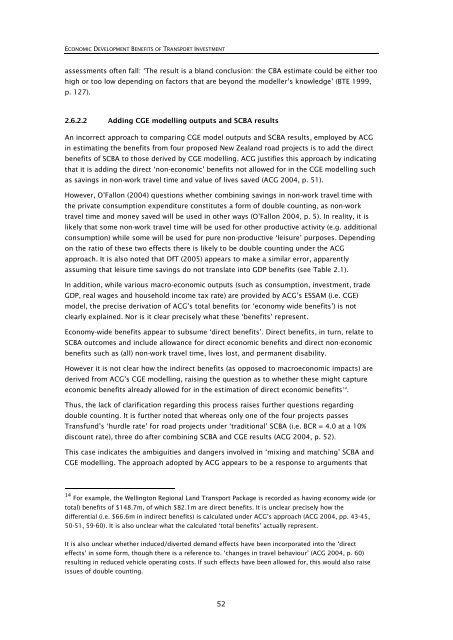Research 350 - NZ Transport Agency
Research 350 - NZ Transport Agency
Research 350 - NZ Transport Agency
Create successful ePaper yourself
Turn your PDF publications into a flip-book with our unique Google optimized e-Paper software.
ECONOMIC DEVELOPMENT BENEFITS OF TRANSPORT INVESTMENT<br />
assessments often fall: ‘The result is a bland conclusion: the CBA estimate could be either too<br />
high or too low depending on factors that are beyond the modeller’s knowledge’ (BTE 1999,<br />
p. 127).<br />
2.6.2.2 Adding CGE modelling outputs and SCBA results<br />
An incorrect approach to comparing CGE model outputs and SCBA results, employed by ACG<br />
in estimating the benefits from four proposed New Zealand road projects is to add the direct<br />
benefits of SCBA to those derived by CGE modelling. ACG justifies this approach by indicating<br />
that it is adding the direct ‘non-economic’ benefits not allowed for in the CGE modelling such<br />
as savings in non-work travel time and value of lives saved (ACG 2004, p. 51).<br />
However, O’Fallon (2004) questions whether combining savings in non-work travel time with<br />
the private consumption expenditure constitutes a form of double counting, as non-work<br />
travel time and money saved will be used in other ways (O’Fallon 2004, p. 5). In reality, it is<br />
likely that some non-work travel time will be used for other productive activity (e.g. additional<br />
consumption) while some will be used for pure non-productive ‘leisure’ purposes. Depending<br />
on the ratio of these two effects there is likely to be double counting under the ACG<br />
approach. It is also noted that DfT (2005) appears to make a similar error, apparently<br />
assuming that leisure time savings do not translate into GDP benefits (see Table 2.1).<br />
In addition, while various macro-economic outputs (such as consumption, investment, trade<br />
GDP, real wages and household income tax rate) are provided by ACG’s ESSAM (i.e. CGE)<br />
model, the precise derivation of ACG’s total benefits (or ‘economy wide benefits’) is not<br />
clearly explained. Nor is it clear precisely what these ‘benefits’ represent.<br />
Economy-wide benefits appear to subsume ‘direct benefits’. Direct benefits, in turn, relate to<br />
SCBA outcomes and include allowance for direct economic benefits and direct non-economic<br />
benefits such as (all) non-work travel time, lives lost, and permanent disability.<br />
However it is not clear how the indirect benefits (as opposed to macroeconomic impacts) are<br />
derived from ACG’s CGE modelling, raising the question as to whether these might capture<br />
economic benefits already allowed for in the estimation of direct economic benefits 14 .<br />
Thus, the lack of clarification regarding this process raises further questions regarding<br />
double counting. It is further noted that whereas only one of the four projects passes<br />
Transfund’s ‘hurdle rate’ for road projects under ‘traditional’ SCBA (i.e. BCR = 4.0 at a 10%<br />
discount rate), three do after combining SCBA and CGE results (ACG 2004, p. 52).<br />
This case indicates the ambiguities and dangers involved in ‘mixing and matching’ SCBA and<br />
CGE modelling. The approach adopted by ACG appears to be a response to arguments that<br />
14 For example, the Wellington Regional Land <strong>Transport</strong> Package is recorded as having economy wide (or<br />
total) benefits of $148.7m, of which $82.1m are direct benefits. It is unclear precisely how the<br />
differential (i.e. $66.6m in indirect benefits) is calculated under ACG’s approach (ACG 2004, pp. 43-45,<br />
50-51, 59-60). It is also unclear what the calculated ‘total benefits’ actually represent.<br />
It is also unclear whether induced/diverted demand effects have been incorporated into the ‘direct<br />
effects’ in some form, though there is a reference to. ‘changes in travel behaviour’ (ACG 2004, p. 60)<br />
resulting in reduced vehicle operating costs. If such effects have been allowed for, this would also raise<br />
issues of double counting.<br />
52
















